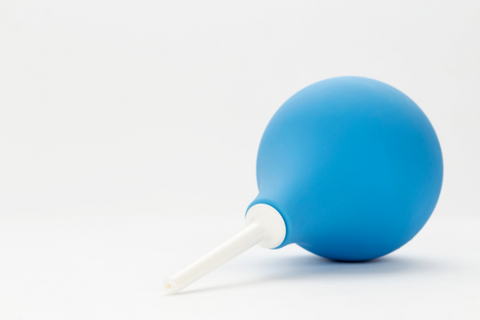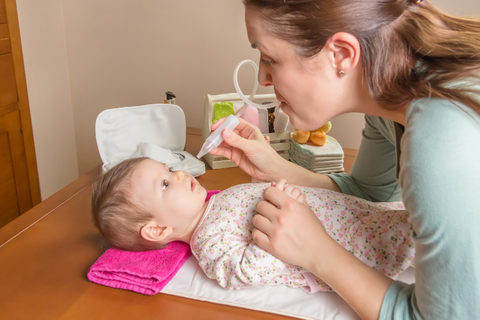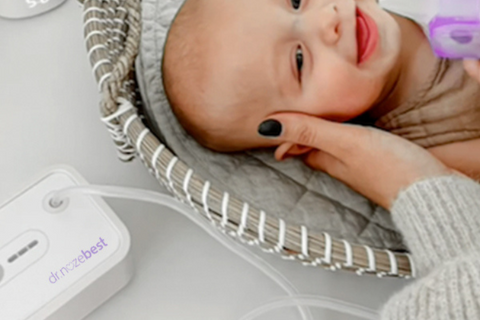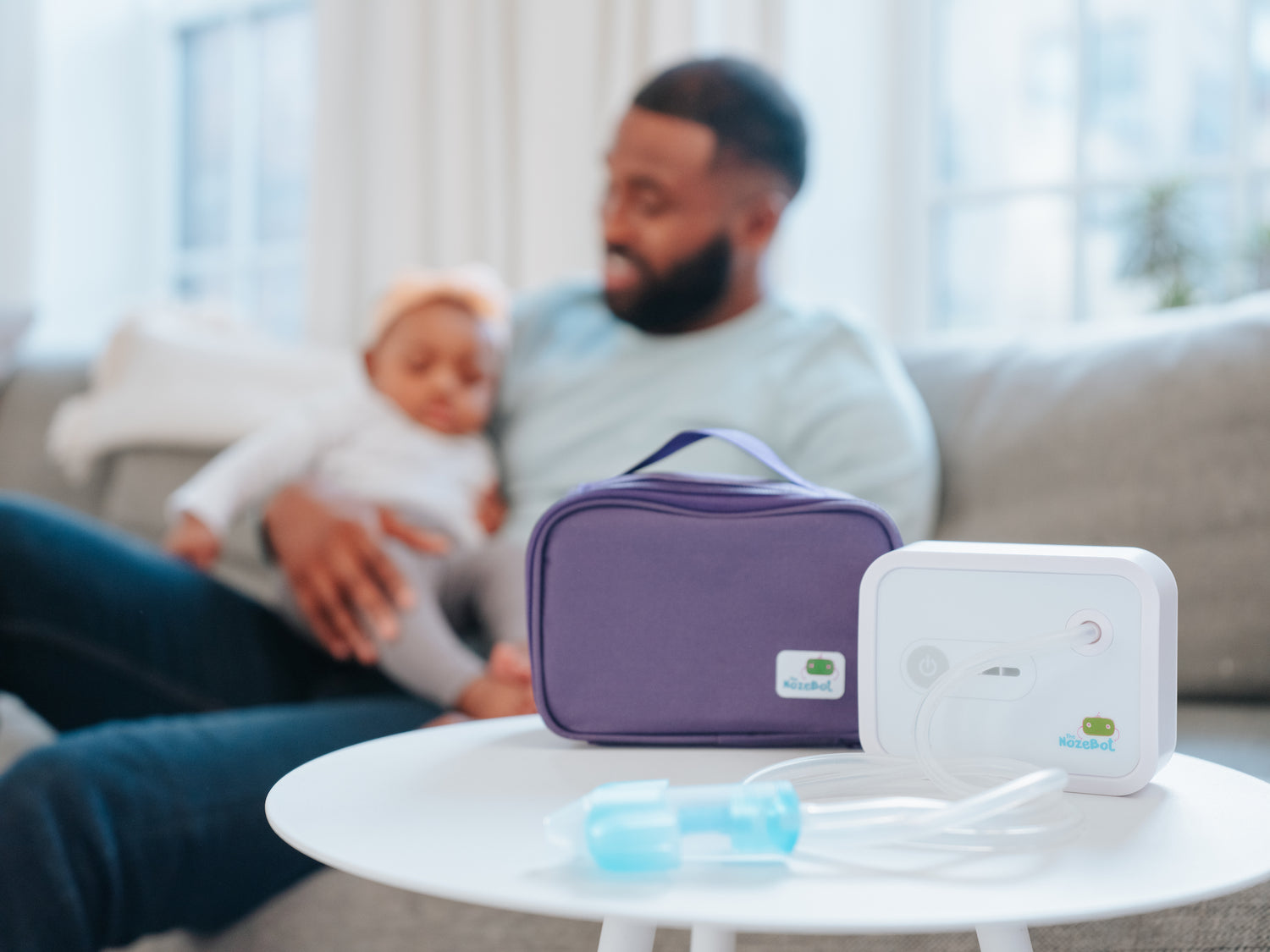This guide will help you understand why this simple device is so important. We’ll look at what nasal aspirators are, how they work, and the different types available. We’ll also discuss the benefits of using one and how to keep it clean.
Table Of Contents
- What Are Nasal Aspirators?
- Types Of Nasal Aspirators
- Benefits Of Using A Nasal Aspirator
- When To Use A Nasal Aspirator
- How To Use A Nasal Aspirator
- When To Go To The Doctor
What Are Nasal Aspirators?
It’s common for babies and young children to suffer from nasal congestion. But unlike older children and adults, they can’t clear their nose on their own.
Fortunately, you can provide relief with a nasal aspirator — a device that uses suction to remove mucus safely from a baby's nasal passages.
It’s true that sucking the snot from your little one’s nose is probably not the bonding moment you dreamed of sharing with your baby. And depending on the age and willingness of your child, the event can more closely resemble a jiu-jitsu match or a bar fight than a tender parenting moment.
Sometimes it makes for great comedy — maybe you’ve seen Sebastian Maniscalco’s hilarious bit on sucking his baby’s snot (Google it!) — but it can also be very distressing for parents concerned that their baby can’t breathe.
Depending on the type of nasal aspirator you use, this process is often a two-person job and leads to a new understanding of your partner’s wrestling abilities!
Types Of Nasal Aspirators
Before inventing the NozeBot, pediatric ENT Dr. Steven Goudy fielded hundreds of concerns from parents lamenting the trials and tribulations of trying to clear their child’s nasal passages.
Whether they were using a bulb syringe, the manual method, or an electric device (we’ll get into all that in a moment), the task could feel like it took three arms — or three people — to keep a child still and administer ample suction.
Let’s examine each of these types of aspirator more closely so you can decide which style is right for you.
Bulb Syringe

Perhaps the most familiar nasal aspirator, these snot-sucking devices have a rubber bulb at one end and a tip at the other.
To suction out snot from your child’s nose, carefully insert the tip into one nostril and repeatedly squeeze the bulb. Then, you must squeeze the snot out onto a tissue or washcloth before inserting it again, which isn’t the most pleasant task.
While bulb syringes are an inexpensive and easy option, they are difficult to clean inside and do not provide a steady stream of suction. Using one also occupies your whole hand, leaving you with only one hand to restrain or comfort your child.
Manual Nasal Aspirators

A little newer on the American parenting scene, manual nasal aspirators work similarly to bulb syringes, with one significant difference. Instead of using your hand to pump a bulb, you use your mouth to create suction and suck the snot out of your baby’s nose through a tube.
While a filter stops the thick mucus before it reaches your mouth, you’re still inhaling virus particles into your own lungs, which could potentially make you sick.
Manual nasal aspirators can also be challenging to clean (especially the long tube). In addition, like the bulb syringe, they don’t provide consistent suction. The speed and flow depend on how much you suck.
On a positive note, these aspirators benefit from a compact design. You can operate it with one hand once you get the hang of it.
However, many caregivers still find it cumbersome to hold down a squirmy, sick child with only one hand while trying to suction the mucus out themselves.
Electric Aspirators
The more Dr. Goudy thought about the problems with nasal aspirators, the more he realized there had to be a better solution.
The families he worked with inspired him to create a fast, easy-to-use home suction solution that provided the same safe and effective suction he could offer at the hospital.
Enter the NozeBot, an electric aspirator that uses a small motor to create consistent, hospital-grade suction. It’s a great choice for those who don't want to use their own mouth suction or who want a cleaner, more effective alternative to the bulb syringe.
However, not all electric nasal aspirators are the same. When comparing models, here are a few things to keep in mind:
- The nosepiece should be wide enough to capture thick mucus. It should also fit easily inside your baby’s nose without going too deep.
- Suction strength matters. Look for an adjustable model with different amounts of sucking power.
- You need to be able to use it independently while supporting your baby. Look for a compact model that you can use with one hand.
- Cleaning should be hassle-free. Make sure you can easily disassemble the unit and clean all the parts.
- Understand how the filters work. Filters keep the snot out of the tubing and keep the procedure sanitary. Since you replace them so often, filters should be easy to order and affordable.

The NozeBot checks all the boxes. It provides hospital-strength suction and an ergonomic nosepiece that only requires two adult fingers to use — not an entire hand. You can support your baby’s face with the same hand that is suctioning.
The NozeBot is portable, rechargeable, adjustable, dishwasher-safe, and strong enough to make the suctioning experience quick and painless for children and adults.
Benefits Of Using A Nasal Aspirator
With a nasal aspirator, you can remove thick and thin mucus from your baby’s nose, providing them with instant relief.
This can help them breathe easier and improve their sleep quality. By keeping their nasal passages clear, you also reduce the risk of sinus infections.
Plus, when your baby’s nose is clogged, it puts pressure on the eustachian tubes, leading to ear infections. Removing all the snot can help prevent future secondary illnesses so your little one stays healthier.
When To Use A Nasal Aspirator
Now that you know more about the different types of nasal aspirators and how they can help, let’s discuss when to use one.
Colds And Other Minor Illnesses
One of the most common reasons to use a nasal aspirator is when your baby has a cold or other minor illness that causes congestion. Mucus can build up in their nasal passages, making it difficult for them to breathe and sleep comfortably.
Removing the excess mucus can help your child get the rest they need to recover.
Allergies
While infants don’t typically have seasonal allergies, they can be allergic to certain environmental things, such as dust, pet dander, or pollen.
These allergies can cause congestion, which you can combat with a nasal aspirator.
Before Feeds And Bed
No matter what’s causing your little one’s nose to get stuffy, it’s important to use a nasal aspirator before they try to eat or sleep.
Eating with a plugged nose can be difficult and uncomfortable for your baby, and they may struggle to consume enough.
Similarly, sleeping with a blocked nose is frustrating and potentially dangerous. Remember, babies breathe through their noses, not their mouths. They need a clear nasal passage to take in enough oxygen.
After Spitting Up
Have you ever seen milk squirting out of your baby’s nose? While it sounds odd, it’s actually a common occurrence for infants. When your baby spits up, some liquid may come out through their nose instead of just their mouth.
As you can probably imagine, milk in the nose isn’t very comfortable. So, if your little one has this issue, use the nasal aspirator to remove the liquid. This will prevent it from drying up there and causing further problems.
It’ll also keep your baby smelling sweeter. Milk up the nose can stink!
How To Use A Nasal Aspirator
Knowing how your nasal aspirator works can help you avoid these common mistakes. While the exact method may vary depending on the type of aspirator you have, here are some general guidelines to follow:
- Be prepared. Before starting the process, have everything you need within reach. Gather a clean aspirator, saline drops, and Noze Wipes or a Snot Trap for the mucus.
- Know your baby will likely fuss. Babies don’t like being held down and the process feels a bit strange, so mentally prepare yourself for tears or screams.
- Wash your hands. Good nasal hygiene starts with good hand hygiene. You don’t want to transfer germs from your fingers to your baby’s nose, so wash up before you begin.
- Use saline drops. Add two or three drops of saline to each side of the nose. This helps break down the mucus. Once the drops are in, wait a few seconds before suctioning so they have time to work.
- Position your baby. Lay your baby on a changing table or bed with their head slightly elevated. This will make it easier to see what you’re doing. If your baby’s a fighter, consider swaddling them before suctioning.
- Gently insert the tip of the aspirator into one nostril. Go slowly and be careful not to shove it too far, or you could cause nasal trauma.
- Begin suctioning. Once you insert the tip, begin suctioning out the snot. If you’re using the NozeBot, start on the low setting and increase the speed as needed. Repeat for your baby’s other nostril.
- Comfort your baby. When your baby’s nostrils are clear, put the nasal aspirator down and pick them up. Talk to them in a soothing voice and comfort them with your touch.
How To Clean A Nasal Aspirator

After you calm your baby down, it’s time to clean your nasal aspirator. While it can be a pain to clean it after each use, doing so is crucial for your baby’s health. It helps prevent the spread of germs and bacteria.
It’s especially important to clean it between uses if you’re using an aspirator for more than one person. Otherwise, you risk spreading illnesses between family members.
Here’s how to clean each type of nasal aspirator.
Cleaning A Bulb Syringe
Start by filling a clean bowl with warm water and a squirt of mild dish soap. Put the tip of the syringe under the water and squeeze to let the water go in.
Shake the syringe around to clean the inside, and squirt out the water. Repeat this process a couple of times to ensure it’s clean.
Then, swap out your soapy water for clean, hot water and continue squeezing water into the bulb and swishing it around to get all of the soap out.
Allow your syringe to dry completely so mold doesn’t grow inside. To ensure all the water drips out, prop it up on a towel with the tip down. Then give it time.
Once you think it’s dry, give the bulb a little squeeze. If any water comes out, let it keep drying.
Cleaning A Manual Nasal Aspirator
You’ll need to disassemble your manual nasal aspirator to clean it properly. Follow the manufacturer's directions to take it apart. Discard the used filter once you remove it.
Wash everything except the tubing in hot, soapy water. Rinse it all in clean water. Then, use a few drops of rubbing alcohol to sanitize the tube.
Finally, let everything dry before reassembling. Remember to add a new filter before you snap it together so it’s ready to use the next time.
Cleaning An Electric Nasal Aspirator
The NozeBot is dishwasher-safe, so it’s easy to clean. Disassemble it, and throw away the used filter.
Then, put the nosepiece and the tubing on the top rack of the dishwasher and let it run through a cycle. Add a new filter, and connect everything again.
Wipe down the electrical unit as needed, being careful not to submerge it in water. Let it dry before you zip it back up into the case.
When To Go To The Doctor

Mild symptoms like a runny nose, coughing, and sneezing aren’t cause for alarm.
In most cases, you’ll be able to provide cold relief to your child with a combination of nasal saline, hydrated wipes, and nasal suction as well as an oral electrolyte solution and fever reducer as needed.
If this is your baby’s first cold, check with your pediatrician to see if they have a recommended regimen, particularly for newborn babies.
However, according to Dr. Goudy, you should be on the lookout for fast breathing, flaring of the nostrils, or belly exertion (pushing the belly in and out). If your baby is lethargic, struggling to breathe, or not eating, they may need to be treated in a hospital.
Most viruses only last for 7-10 days and cause mild to moderate symptoms. Respiratory syncytial virus (RSV), on the other hand, is an example of a more serious virus. It is the most common cause of pneumonia in infants.
RSV can cause mild respiratory symptoms (cough, runny nose), or it can become severe and require hospitalization for respiratory support.
Dr. Goudy says trust your instincts. “If your child is using additional muscles to breathe, they look lethargic, or you just feel like something's seriously wrong, you need to seek medical attention right away.”
Better Breathing, Happier Baby!

A nasal aspirator removes the snot from your baby’s nose so they can breathe better. It’s an essential tool for parents, especially during cold and flu season!
If you’re looking for an effective and safe way to keep your baby’s nose clean, the NozeBot Starter Bundle is the perfect solution. This nasal aspirator bundle comes with the following:
With these supplies, you can navigate your baby’s sick days, no matter how much snot comes your way.
If you have any questions about nasal aspirators or want to know how to use your NozeBot, don’t hesitate to contact us!
If you enjoyed learning more about nasal aspirators, you will love these articles, too:
- Cold Relief Tips For Your Family
- What Parents Need to Know About Ear Infections
- How to Prepare For Back to School Bugs
- 5 Mistakes Parents Make, According to a Pediatric ENT
- What to Do Immediately When Your Child Is In Respiratory Distress
*The content on this site is not intended to be a substitute for professional medical advice, diagnosis, or treatment. Always seek the advice of your physician or other qualified health provider with any questions you may have regarding a medical condition for you or your child.
Our nasal aspirator will help!



